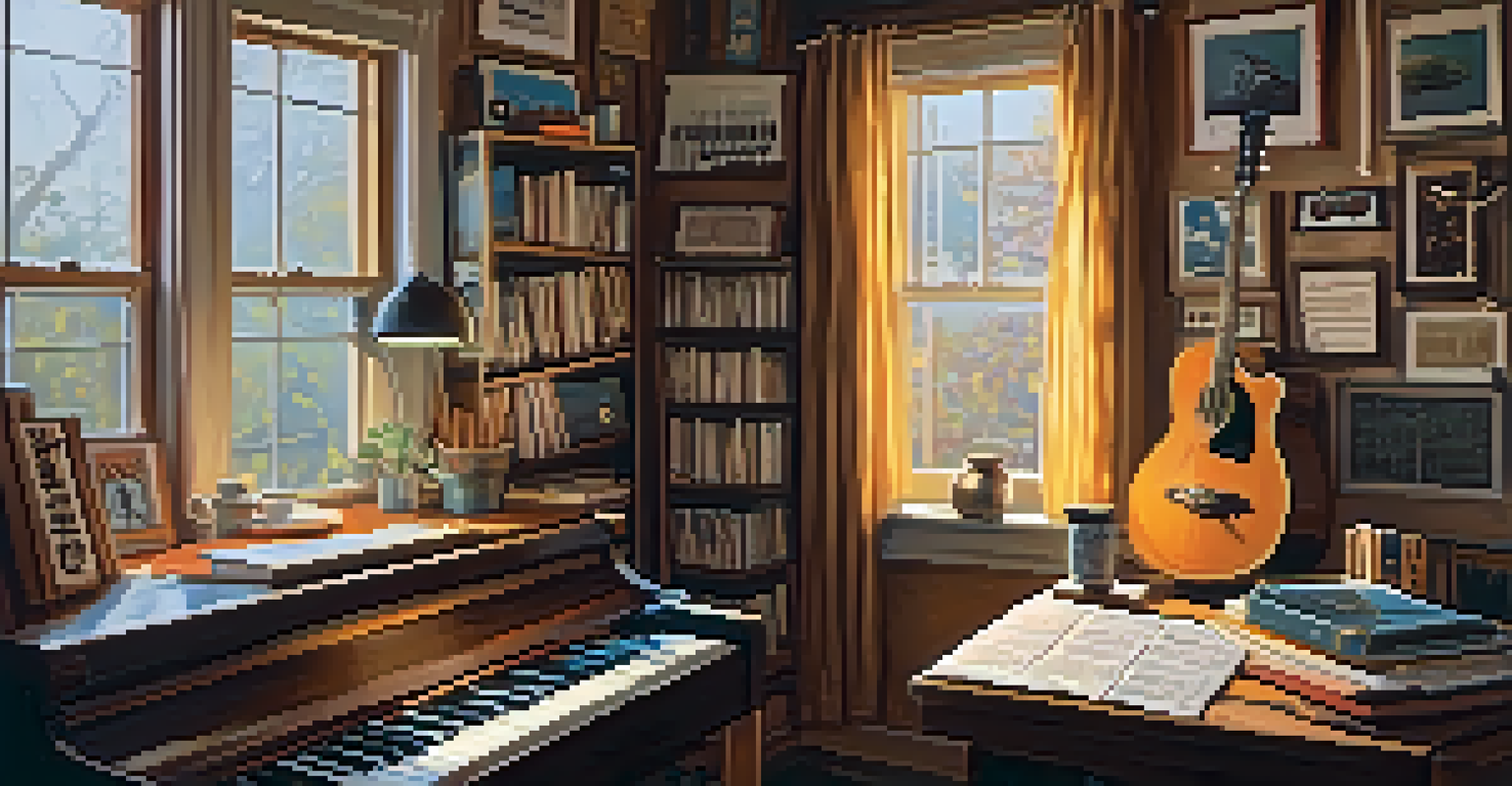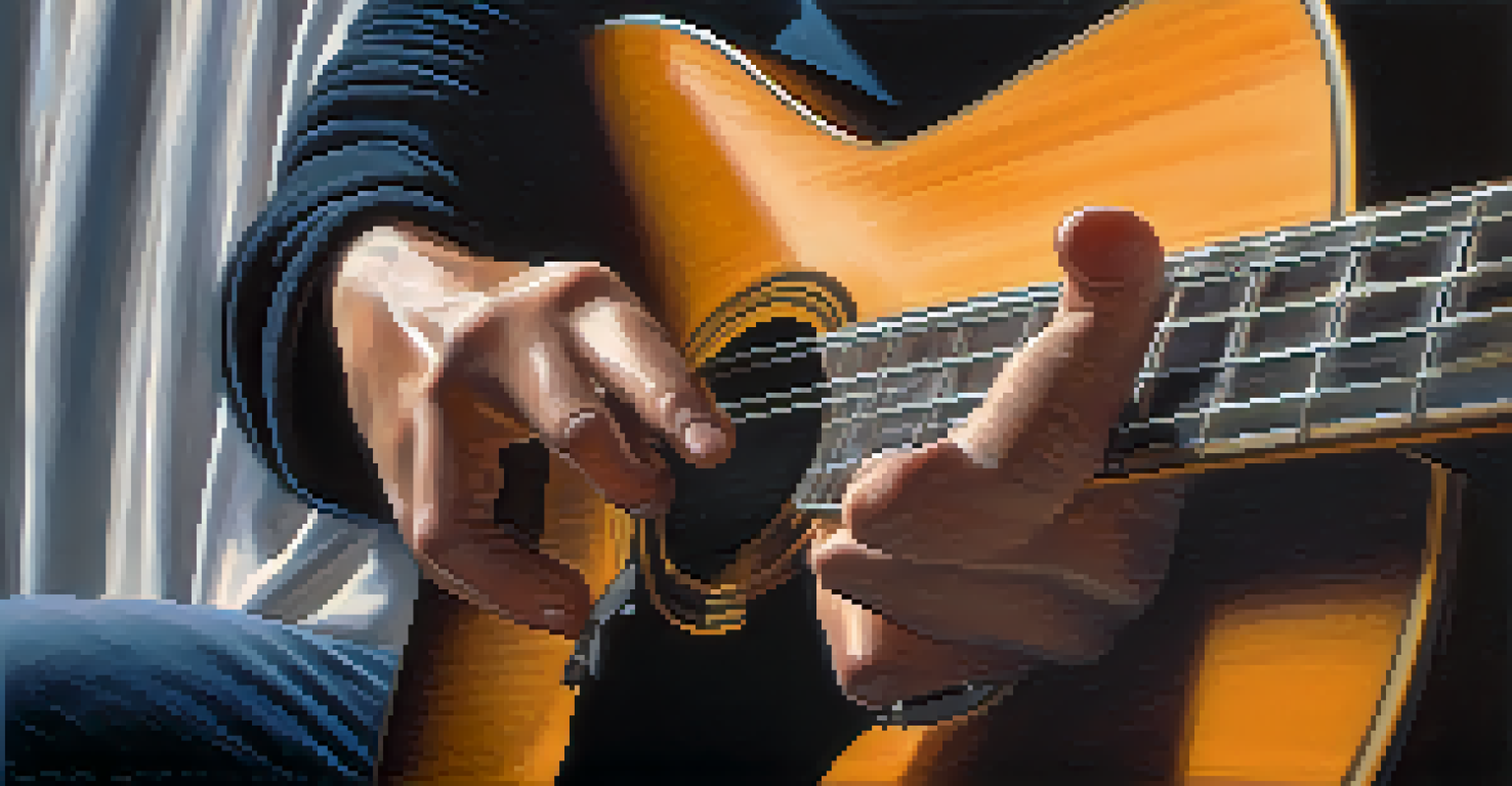Building Emotional Chord Progressions for Guitar

Understanding the Role of Chord Progressions
Chord progressions are the backbone of any song, setting the mood and tone. They can evoke a wide range of emotions, from joy and nostalgia to sadness and anger. By choosing the right chords, you can guide your listeners through a journey that resonates deeply with them.
Music can change the world because it can change people.
Think of chord progressions like a conversation. Just as different tones can change the meaning of your words, the choice of chords can shift the emotional landscape of your music. A simple progression can tell a story, inviting listeners to engage with the feelings behind the notes.
Understanding how to build these progressions can empower you as a guitarist. It's not merely about playing notes; it's about creating an emotional connection that lingers long after the last chord has rung out.
Exploring Major and Minor Chords
Major chords often convey happiness and brightness, while minor chords tend to evoke feelings of sadness or introspection. This fundamental difference is crucial when crafting emotional progressions. For instance, a simple major chord can uplift a listener, while a minor chord can bring a reflective quality to your music.

Consider a scenario where you use a C major chord followed by an A minor. The shift from major to minor can create a poignant moment in your composition, allowing the listener to feel the contrast. This interplay is what makes your progression compelling and relatable.
Chord Progressions Shape Emotions
Chord progressions are essential in evoking emotions and guiding listeners through a musical journey.
Experimenting with both major and minor chords in your progressions can help you discover various emotional textures. Don't hesitate to mix them up and see how they work together to create a richer sound.
Using Suspended and Seventh Chords for Emotion
Suspended chords, or 'sus' chords, add a sense of tension and anticipation. They can make a listener feel like something is about to happen, which is perfect for building emotional crescendos in your music. For example, a Dsus4 can create a moment of suspense before resolving to a D major chord.
The only truth is music.
Seventh chords, on the other hand, introduce complexity and depth. They can add a jazzy feel or a touch of melancholy, depending on their placement in a progression. A Cmaj7 chord, for instance, can evoke a dreamy quality, inviting listeners to lose themselves in the music.
Incorporating these types of chords can enhance your emotional storytelling. They provide a rich palette to paint your musical narrative, allowing you to explore various feelings and moods.
The Power of Inversions in Progressions
Chord inversions involve rearranging the notes in a chord, giving it a different sound and feel. This technique can add variety and maintain listener interest, especially in longer pieces. For instance, playing a C major chord in its first inversion can change the emotional impact of your progression.
Inversions can also create smoother transitions between chords. Instead of jumping from one position to another, using inversions can provide a more seamless flow. This fluidity helps maintain the emotional continuity of your piece, making it feel cohesive.
Major vs Minor Chords Matter
The choice between major and minor chords significantly impacts the emotional tone of your music.
Experimenting with inversions can lead to unexpected emotional discoveries. By altering the structure of your chords, you might find new ways to express your musical ideas.
The Importance of Rhythm in Emotional Progressions
Rhythm plays a pivotal role in how emotional a chord progression feels. The tempo and strumming pattern can drastically change the mood of your music. A slow, deliberate rhythm can evoke a sense of longing, while a fast, upbeat tempo might create excitement.
For example, consider playing a simple progression like G - C - D slowly versus quickly. The slower tempo allows for reflection, while the faster pace encourages movement and energy. This illustrates how rhythm can amplify the emotions you want to convey.
Paying attention to rhythm can enhance your chord progressions significantly. It’s not just about the chords you play but how you play them that makes all the difference.
Experimenting with Unconventional Chord Progressions
Don't be afraid to step outside the box! Unconventional chord progressions can lead to unique emotional experiences. By straying from standard patterns, you might discover unexpected feelings and sounds that resonate with you and your audience.
For instance, try using a progression like Em - C - G - D, which deviates from the typical major chord structure. This type of progression can evoke a sense of yearning and depth, drawing listeners into an emotional spiral.
Rhythm Enhances Emotional Impact
The rhythm and tempo of your chord progressions play a crucial role in amplifying the intended emotions.
Experimentation is key in music. By trying out different combinations, you might stumble upon a progression that perfectly captures the emotion you’re aiming for.
Crafting Your Emotional Musical Story
Every chord progression tells a story, and as a guitarist, you have the power to shape that narrative. Think about the journey you want to take your listeners on and choose chords that reflect that emotional arc. Perhaps you want to start with a sense of hope, progress to a moment of conflict, and resolve with peace.
As you assemble your chords, consider the feelings they evoke and how they transition from one to the next. The emotional peaks and valleys you create can mirror real-life experiences, allowing listeners to connect with your music on a personal level.

Ultimately, it’s about authenticity. Share your feelings through your progressions, and don’t shy away from vulnerability. Your emotional story will resonate with others, creating a powerful bond through music.